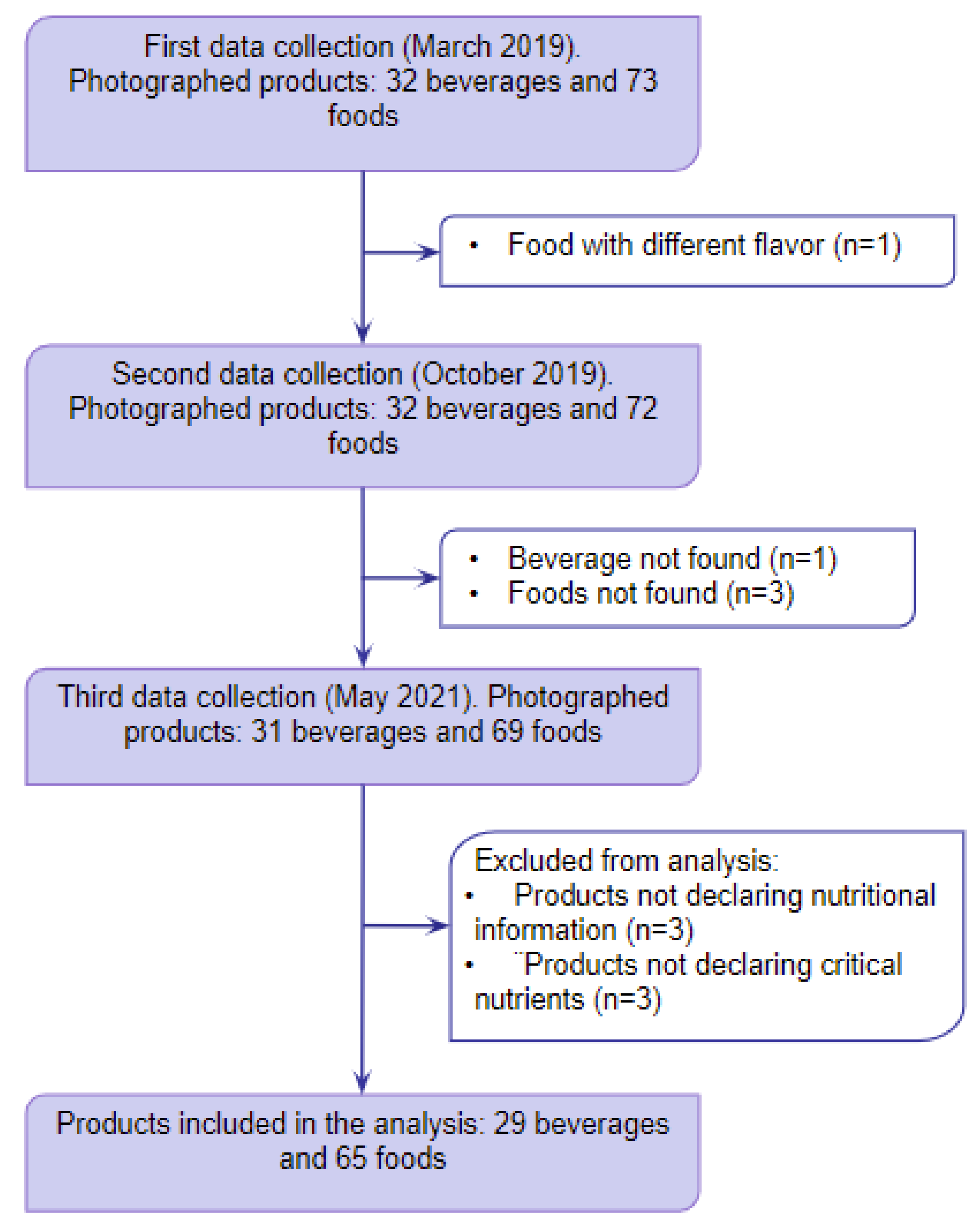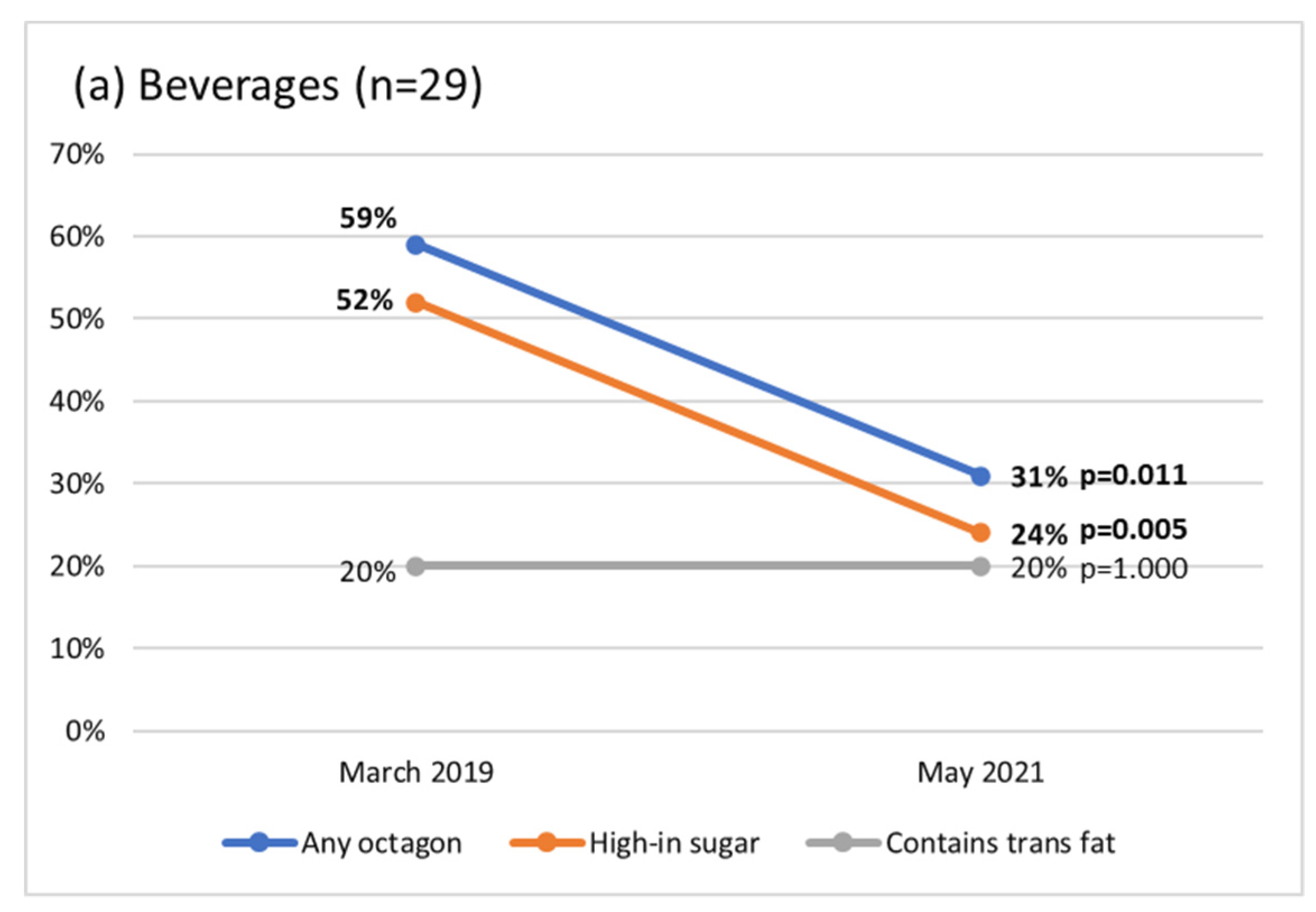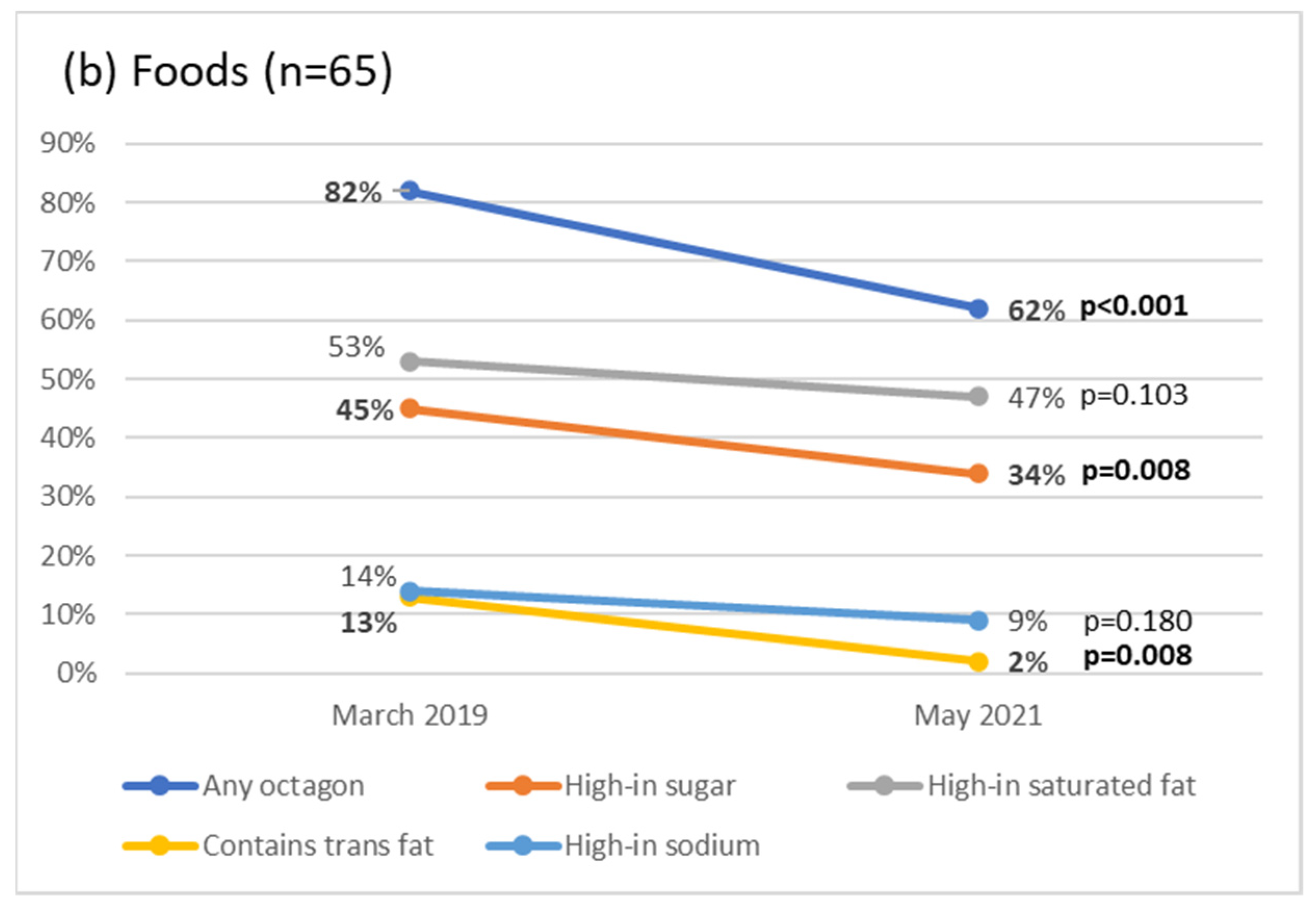Reformulation of Top-Selling Processed and Ultra-Processed Foods and Beverages in the Peruvian Food Supply after Front-of-Package Warning Label Policy
Abstract
1. Introduction
2. Materials and Methods
2.1. Study Design
2.2. Setting
2.3. Sampling Methods
2.4. Data Collection and Entry
2.5. Outcomes
- the content of nutrients of concern (grams of total sugar, saturated fats, trans fats, and sodium) per 100 g or 100 mL of products as consumed;
- the percentage of products containing NNS, including polyols (see Supplementary Material Table S2), and monosodium glutamate (MSG), ingredients used to replace sugar and salt, respectively;
- the percentage of processed and ultra-processed products that would carry FOPWLs according to the parameters of the first phase of the FOPWL policy (Table 1).
2.6. Statistical Analysis
3. Results
4. Discussion
5. Conclusions
Supplementary Materials
Author Contributions
Funding
Institutional Review Board Statement
Informed Consent Statement
Data Availability Statement
Acknowledgments
Conflicts of Interest
References
- Templin, T.; Hashiguchi, T.C.O.; Thomson, B.; Dieleman, J.; Bendavid, E. The overweight and obesity transition from the wealthy to the poor in low- and middle-income countries: A survey of household data from 103 countries. PLoS Med. 2019, 16, e1002968. [Google Scholar] [CrossRef] [PubMed]
- Instituto Nacional de Estadística e Informática. Perú: Enfermedades no Transmisibles y Transmisibles; Instituto Nacional de Estadística e Informática: Lima, Peru, 2020. Available online: https://proyectos.inei.gob.pe/endes/2020/SALUD/ENFERMEDADES_ENDES_2020.pdf (accessed on 3 November 2022).
- Centro Nacional de Alimentación y Nutrición. Documento Técnico: Plan Nacional de la Estrategia Sanitaria Nacional de Alimentación y Nutrición Saludable. Periodo 2014–2016. 2018. Available online: https://observateperu.ins.gob.pe/images/archivos/situacion-nutricional/4.1_Tendencia_del_sobrepeso_y_obesidad_en_nias_y_nios_de_5_a_9_aos.pdf (accessed on 3 November 2022).
- Organización Panamericana de la Salud. Alimentos y Bebidas ultra Procesados en América Latina: Ventas. Fuentes. Perfiles de Nutrientes e Implicaciones; OPS: Washington DC, USA, 2019. [Google Scholar]
- Meza-Hernández, M.; Villarreal-Zegarra, D.; Saavedra-Garcia, L. Nutritional Quality of Food and Beverages Offered in Supermarkets of Lima According to the Peruvian Law of Healthy Eating. Nutrients 2020, 12, 1508. [Google Scholar] [CrossRef] [PubMed]
- Hall, K.D.; Ayuketah, A.; Brychta, R.; Cai, H.; Cassimatis, T.; Chen, K.Y.; Chung, S.T.; Costa, E.; Courville, A.; Darcey, V.; et al. Ultra-Processed Diets Cause Excess Calorie Intake and Weight Gain: An Inpatient Randomized Controlled Trial of Ad Libitum Food Intake. Cell Metab. 2019, 30, 67–77.e3. [Google Scholar] [CrossRef] [PubMed]
- Pagliai, G.; Dinu, M.; Madarena, M.P.; Bonaccio, M.; Iacoviello, L.; Sofi, F. Consumption of ultra-processed foods and health status: A systematic review and meta-analysis. Br. J. Nutr. 2020, 125, 308–318. [Google Scholar] [CrossRef]
- Congreso de la República. Ley de Promoción de la Alimentación Saludable Para Niños. Niñas y Adolescentes. LEY No 30021. Available online: https://leyes.congreso.gob.pe/Documentos/Leyes/30021.pdf (accessed on 3 November 2022).
- Ministerio de Salud. Reglamento que Establece el Proceso de Reducción Gradual Hasta la Eliminación de las Grasas Trans en Alimentos y Bebidas no Alcohólicas Procesados Industrialmente. DECRETO SUPREMO No 033-2016-SA. Available online: https://busquedas.elperuano.pe/normaslegales/aprueban-el-reglamento-que-establece-el-proceso-de-reduccion-decreto-supremo-n-033-2016-sa-1409585-3/ (accessed on 3 November 2022).
- Ministerio de Economía y Finanzas. Decreto Supremo que Modifica el Impuesto Selectivo al Consumo Aplicable a los Bienes del Nuevo Apéndice IV del TUO de la Ley del Impuesto General a las Ventas e Impuesto Selectivo al Consumo y el Reglamento de la Ley del Impuesto a la Renta-DECRETO SUPREMO-N° 181-2019-EF. 181-2019-EF. Available online: http://busquedas.elperuano.pe/normaslegales/decreto-supremo-que-modifica-el-impuesto-selectivo-al-consum-decreto-supremo-n-181-2019-ef-1779615-2/ (accessed on 3 November 2022).
- Diez-Canseco, F.; Cavero, V.; Alvarez-Cano, J.; Saavedra-Garcia, L.; Taillie, L.S.; Carpentier, F.D.; Miranda, J.J. Design and approval of the nutritional warnings’ policy in Peru: Milestones, key stakeholders, and policy drivers for its approval. MedRxiv 2022. [Google Scholar] [CrossRef]
- Ministerio de Salud. Manual de Advertencias Publicitarias en el marco de lo Establecido en Ley No 30021. Ley de Promoción de la Alimentación Saludable Para Niños. Niñas y Adolescentes. y su Reglamento Aprobado por Decreto Supremo No 017-2017-sa. DECRETO SUPREMO No 012-2018-SA. Available online: https://busquedas.elperuano.pe/download/url/aprueban-manual-de-advertencias-publicitarias-en-el-marco-de-decreto-supremo-n-012-2018-sa-1660606-1 (accessed on 2 November 2022).
- Hawkes, C.; Smith, T.G.; Jewell, J.; Wardle, J.; Hammond, R.A.; Friel, S.; Thow, A.M.; Kain, J. Smart food policies for obesity prevention. Lancet 2015, 385, 2410–2421. [Google Scholar] [CrossRef]
- Scarpelli, D.Q.; Fernandes, A.C.P.; Osiac, L.R.; Quevedo, T.P. Changes in Nutrient Declaration after the Food Labeling and Advertising Law in Chile: A Longitudinal Approach. Nutrients 2020, 12, 2371. [Google Scholar] [CrossRef]
- Reyes, M.; Taillie, L.S.; Popkin, B.; Kanter, R.; Vandevijvere, S.; Corvalán, C. Changes in the amount of nutrient of packaged foods and beverages after the initial implementation of the Chilean Law of Food Labelling and Advertising: A nonexperimental prospective study. PLoS Med. 2020, 17, e1003220. [Google Scholar] [CrossRef]
- Herrera, A.M.M.; Crino, M.; Erskine, H.E.; Sacks, G.; Ananthapavan, J.; Mhurchu, C.N.; Lee, Y.Y. Cost-Effectiveness of Product Reformulation in Response to the Health Star Rating Food Labelling System in Australia. Nutrients 2018, 10, 614. [Google Scholar] [CrossRef]
- Scrinis, G.; Monteiro, C.A. Ultra-processed foods and the limits of product reformulation. Public Health Nutr. 2018, 21, 247–252. [Google Scholar] [CrossRef]
- Martínez, X.; Zapata, Y.; Pinto, V.; Cornejo, C.; Elbers, M.; van der Graaf, M.; Villarroel, L.; Hodgson, M.I.; Rigotti, A.; Echeverría, G. Intake of Non-Nutritive Sweeteners in Chilean Children after Enforcement of a New Food Labeling Law that Regulates Added Sugar Content in Processed Foods. Nutrients 2020, 12, 1594. [Google Scholar] [CrossRef]
- Ricardo, C.Z.; Corvalán, C.; Taillie, L.S.; Quitral, V.; Reyes, M. Changes in the Use of Non-nutritive Sweeteners in the Chilean Food and Beverage Supply after the Implementation of the Food Labeling and Advertising Law. Front. Nutr. 2021, 8, 906. [Google Scholar]
- Federici, C.; Detzel, P.; Petracca, F.; Dainelli, L.; Fattore, G. The impact of food reformulation on nutrient intakes and health. A systematic review of modelling studies. BMC Nutr. 2019, 5, 2. [Google Scholar] [CrossRef] [PubMed]
- Euromonitor Internacional. Passport Global Market Information Database. 2019. Available online: http://www.euromonitor.com/ (accessed on 3 November 2022).
- Kanter, R.; Reyes, M.; Vandevijvere, S.; Swinburn, B.; Corvalán, C. Anticipatory effects of the implementation of the Chilean Law of Food Labeling and Advertising on food and beverage product reformulation. Obes. Rev. 2019, 20, 129–140. [Google Scholar] [CrossRef]
- Harris, P.A.; Taylor, R.; Thielke, R.; Payne, J.; Gonzalez, N.; Conde, J.G. Research Electronic Data Capture (REDCap)—A metadata-driven methodology and workflow process for providing translational research informatics support. J. Biomed. Inform. 2009, 42, 377–381. [Google Scholar] [CrossRef] [PubMed]
- U.S. Department of Agriculture, Agricultural Research Service. USDA Food and Nutrient Database for Dietary Studies 2017–2018. Food Surveys Research Group Home Page. 2020. Available online: https://www.ars.usda.gov/ARSUserFiles/80400530/pdf/fndds/2017_2018_FNDDS_Doc.pdf (accessed on 3 November 2022).
- Rebolledo, N.; Reyes, M.; Popkin, B.M.; Adair, L.; Avery, C.L.; Corvalán, C.; Ng, S.W.; Taillie, L.S. Changes in nonnutritive sweetener intake in a cohort of preschoolers after the implementation of Chile’s Law of Food Labelling and Advertising. Pediatr. Obes. 2022, 17, e12895. [Google Scholar] [CrossRef] [PubMed]
- Stanner, S.A.; Spiro, A. Public health rationale for reducing sugar: Strategies and challenges. Nutr. Bull. 2020, 45, 253–270. [Google Scholar] [CrossRef]
- Erickson, S.; Carr, J. The technological challenges of reducing the sugar content of foods. Nutr. Bull. 2020, 45, 309–314. [Google Scholar] [CrossRef]
- Vandevijvere, S.; Vanderlee, L. Effect of Formulation. Labelling. and Taxation Policies on the Nutritional Quality of the Food Supply. Curr. Nutr. Rep. 2019, 8, 240–249. [Google Scholar] [CrossRef]
- Allemandi, L.; Tiscornia, M.V.; Ponce, M.; Castronuovo, L.; Dunford, E.; Schoj, V. Sodium content in processed foods in Argentina: Compliance with the national law. Cardiovasc. Diagn. Ther. 2015, 5, 197–206. [Google Scholar]
- The Impact of Voluntary Targets on the Sodium Content of Processed Foods in Brazil. 2011–2013. Available online: https://onlinelibrary.wiley.com/doi/10.1111/jch.13044 (accessed on 20 December 2021).
- Secretaria de Economía Mexicana. Especificaciones Generales de Etiquetado para Alimentos y Bebidas no Alcohólicas pre Envasados-Información Comercial y Sanitaria. NOM-051-SCFI/SSA1-2010 oct 1. 2020. Available online: https://www.dof.gob.mx/normasOficiales/4010/seeco11_C/seeco11_C.htm (accessed on 3 November 2022).
- Senado y Cámara de Diputados de la Nación Argentina. PROMOCIÓN DE LA ALIMENTACIÓN SALUDABLE—Ley 27642. Ley 27642. Available online: https://www.boletinoficial.gob.ar/detalleAviso/primera/252728/20211112 (accessed on 3 November 2022).
- Shum, B.; Georgia, S. The Effects of Non-Nutritive Sweetener Consumption in the Pediatric Populations: What We Know, What We Don’t, and What We Need to Learn. Front. Endocrinol. 2021, 12, 625415. [Google Scholar] [CrossRef] [PubMed]




| Nutrient of Concern | Product | Term of Entry into Force | |
|---|---|---|---|
| First Phase (June 2019) | Second Phase (September 2021) | ||
| Total sugars | Solids | Greater than or equal to 22.5 g/100 g | Greater than or equal to 10 g/100 g |
| Beverages | Greater than or equal to 6 g/100 mL | Greater than or equal to 5 g/100 mL | |
| Saturated fats | Solids | Greater than or equal to 6 g/100 g | Greater than or equal to 4 g/100 g |
| Beverages | Greater than or equal to 3 g/100 mL | Greater than or equal to 3 g/100 mL | |
| Sodium | Solids | Greater than or equal to 800 mg/100 g | Greater than or equal to 400 mg/100 mL |
| Beverages | Greater than or equal to 100 mg/100 mL | Greater than or equal to 100 mg/100 mL | |
| Trans fats | Solids and beverages | Contains trans fats | Added trans fats prohibited [10] |
| Nutrient | Period | Beverages (n = 29) | Foods (n = 65) |
|---|---|---|---|
| Sugar (g) | n (%) * | 29 (100) | 64 (98.5) |
| March 2019 | 9.0 (4.7) a | 11.4 (31.9) | |
| October 2019 | 5.9 (3.8) b | 16.4 (26.3) | |
| May 2021 | 5.9 (3.1) b | 15.6 (28.0) | |
| Saturated fat (g) | n (%) * | 13 (44.8) | 62 (95.4) |
| March 2019 | 1.0 (1.0) | 6.7 (10.6) a | |
| October 2019 | 1.0 (1.0) | 5.4 (11.6) b | |
| May 2021 | 1.0 (1.0) | 5.9 (11.6) b | |
| Trans fats (g) | n (%) * | 10 (34.5) | 61 (93.8) |
| March 2019 | 0 (0) | 0 (0) a,† | |
| October 2019 | 0 (0) | 0 (0) b | |
| May 2021 | 0 (0) | 0 (0) b | |
| Sodium (mg) | n (%) * | 29 (100) | 65 (100) |
| March 2019 | 16.0 (37.8) | 339.0 (451.0) | |
| October 2019 | 16.0 (41.0) | 343.9 (430.0) | |
| May 2021 | 25.5 (42.0) | 339.0 (478.0) |
Disclaimer/Publisher’s Note: The statements, opinions and data contained in all publications are solely those of the individual author(s) and contributor(s) and not of MDPI and/or the editor(s). MDPI and/or the editor(s) disclaim responsibility for any injury to people or property resulting from any ideas, methods, instructions or products referred to in the content. |
© 2022 by the authors. Licensee MDPI, Basel, Switzerland. This article is an open access article distributed under the terms and conditions of the Creative Commons Attribution (CC BY) license (https://creativecommons.org/licenses/by/4.0/).
Share and Cite
Saavedra-Garcia, L.; Meza-Hernández, M.; Diez-Canseco, F.; Taillie, L.S. Reformulation of Top-Selling Processed and Ultra-Processed Foods and Beverages in the Peruvian Food Supply after Front-of-Package Warning Label Policy. Int. J. Environ. Res. Public Health 2023, 20, 424. https://doi.org/10.3390/ijerph20010424
Saavedra-Garcia L, Meza-Hernández M, Diez-Canseco F, Taillie LS. Reformulation of Top-Selling Processed and Ultra-Processed Foods and Beverages in the Peruvian Food Supply after Front-of-Package Warning Label Policy. International Journal of Environmental Research and Public Health. 2023; 20(1):424. https://doi.org/10.3390/ijerph20010424
Chicago/Turabian StyleSaavedra-Garcia, Lorena, Mayra Meza-Hernández, Francisco Diez-Canseco, and Lindsey Smith Taillie. 2023. "Reformulation of Top-Selling Processed and Ultra-Processed Foods and Beverages in the Peruvian Food Supply after Front-of-Package Warning Label Policy" International Journal of Environmental Research and Public Health 20, no. 1: 424. https://doi.org/10.3390/ijerph20010424
APA StyleSaavedra-Garcia, L., Meza-Hernández, M., Diez-Canseco, F., & Taillie, L. S. (2023). Reformulation of Top-Selling Processed and Ultra-Processed Foods and Beverages in the Peruvian Food Supply after Front-of-Package Warning Label Policy. International Journal of Environmental Research and Public Health, 20(1), 424. https://doi.org/10.3390/ijerph20010424






